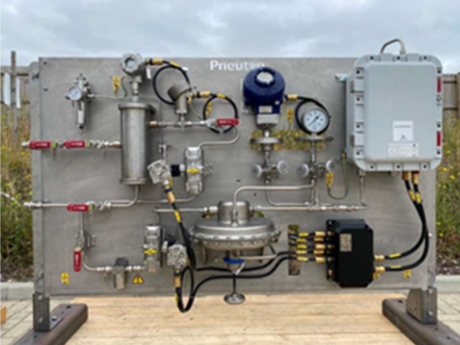Highlights
Benefits
- Low cost, robust system that requires minimal maintenance
- Enables proactive preventative maintenance options to avoid costly riser failure events
Features
- RTVGM measures flow and pressure in the annulus as well as the concentration of gasses; CO2, CH4, H2S and O2
- Provides continuous real-time data to enable to gas to be analysed under in-situ conditions
Applications
- Can be fitted to new or existing flexible risers and flowlines
- Provides highly valuable information when producing from fields in corrosive gases or susceptible to well souring
- The system is a multiplexing system which can handle up to eight individual risers
Baker Hughes Real Time Vent Gas Monitoring System™ (RTVGM™) is a flexible pipe vent gas monitoring system which performs chemical analysis on permeated annulus gases in real time. Real time vent gas analysis provides highly valuable data when producing from fields high in corrosive gases (H2S/CO2) or susceptible to well souring. RTVGM allows the operator to monitor the evolution of such gas species within the flexible pipe annulus over the entire service life.
Using RTVGM it is possible to monitor changes in the annulus gases over life of field as the reservoir matures and as additional wells are brought online. The resulting data allows intelligent field management decisions to be taken and can be used to justify field life extension.
Vent gas monitoring is an established technology within the flexible pipe industry. Legacy vent gas monitoring systems are however limited to gas pressure / flow measurement capability. Legacy work on the basis that irregularities in the measured gas pressure / flow rate are indicative of disturbance in the riser system which then requires further investigation. Many legacy vent gas monitoring systems do allow gas samples to be retrieved manually and sent to an onshore laboratory for analysis. This approach for gas monitoring is however costly, does not provide continuous data and does not enable the gas to be analysed under in-situ conditions.
Baker Hughes RTVGM technology takes vent gas monitoring technology into the 21st century by facilitating continuous real time measurement of composition with the gas species being analysed in-situ.
Using cloud-based software real time data is streamed back ‘to the beach’ for 24/7 review.
Engineering Principle
Baker Hughes RTVGM uses a nondispersive infrared (NDIR) spectrometry and electrochemical methods to analyse the composition of permeated gases exiting topside end fitting of a flexible riser system. Different gas species absorb infrared radiation differently at different wavelengths. By measuring transmission of infrared radiation at specific wavelengths it is possible determine the concentration of each gas component. This technology is well proven and routine practice in the HVAC and process industries.
The data collected using RTVGM can be used to identify the composition of permeated gases in-situ. This data can also be used to verify gas permeation predictions and monitor changes in permeation rates. As such, any changes to the annulus environment late in field life, for example due to tie-back of additional wells, can be monitored to ensure continued fluid compatibility.
RTVGM combines powerful NDIR spectrometry with modern communication functionality leveraging on Baker Hughes proven capabilities in digital engineering. The RTVGM unit may be connected to a cloud-based data system allowing constant streaming of data
Implementation
The RTVGM system is connected to a 1/8” NPT threaded gas relief port fitted as standard in Baker Hughes topside riser end fittings. As such RTVGM™ may be implemented in either new or existing riser systems. Downstream the system is connected via threaded port to the gas disposal system allowing gas to be vented per standard practice.
The control unit is a compact permanent installation although a portable unit is available to operators to perform field testing prior to permanent implementation.
Qualification Status
Baker Hughes RTVGM is fully qualified through laboratory testing and its accuracy independently verified.


